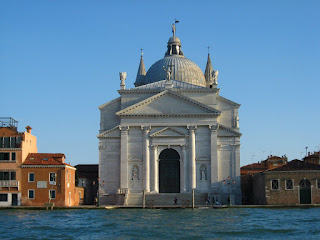The other members of the General Definitory and I have just completed our meeting with the Italian Conference of Capuchin Provincial Ministers (CIMPCap). The meeting was held in Venice at the Friary of Our Most Holy Redeemer, which is attached to the shrine (pictured here) of the same name. The shrine, I seem to remember, was built as a thanksgiving offering by the people of Venice for having been spared from the worst of the Black Death that ravaged much of Italy.
The Capuchin Conference in Italy is the largest in the Order, with between 2,220 and 2,400 friars, depending on how you count them. While Capuchins are still quite numerous in Italy, their number has fallen significantly in recent years. Part of the reason for the decline can be found in the secularization that has taken root in Italian society, a factor that it has in common with the other western European conferences and with the NAPCC. Because of this numerical decline, provinces in Italy are facing many of the same struggles that face provinces in the NAPCC: the need to close friaries and withdraw from ministries that are no longer sustainable, the difficulty of finding an adequate number of friars to be guardians, formation directors, pastors, etc. and the difficulty of finding sufficient income with a dwindling workforce, among others.
In other ways, the experience of the Italian provinces is different from that of the provinces in the NAPCC. For one thing, the friaries that the Capuchins are closing in Italy are often almost 500 years old, and are sometimes one of the town's major landmarks. Understandably, such a closure is traumatic both for the friars and for the people they served. Another important difference is that, while vocations are increasing in many parts of the NAPCC, they have not picked up in Italy. The Italian Conference had roughly the same number of novices this year as the NAPCC (around 15), even though there are four times as many friars in CIMPCap than in the NAPCC.
Despite the obvious challenges facing our brothers in Italy, they are looking to the future with hope. The painful process of downsizing is being looked at as a chance to return to the essentials of our life. Rather than merely continuing to do what they have always done, the provinces in Italy are looking for new ways of serving the poor with a spirit of minority. Rather than giving up in the face of their difficulties, they are working to recapture the spirit that once led them to be called, "Brothers of the people."


4 comments:
Perhaps we members of NAPCC should seek ways to share strategies and experience with CIMPCap, if we are in such a similar historical moment and challenge.
No post on the visitation of the Province of the Immaculate Heart of Mary? We are perhaps not so exciting. ;-)
Re my report on the NT visitation, it needs time to gestate, or ferment, or something like that.
Hi Mark. "...between 2,220 and 2,400 friars, depending on how you count them." I'm curious, what does it mean?
Claudio Cerfoglia
Claudio: It is notoriously difficult to count the number of friars in a Conference. A friar might be a member of an Indian province, be assigned to a mission in East Africa, but live in Rome while doing advanced studies. Therefore, should he be counted in CCMSI, EACC or CIMPCap? There are many friars in Italy for either educational or ministerial reasons. On the other hand, there are many Italian friars living and working outside Italy. Based on how you define "in the Conference", one can have different answers.
Post a Comment